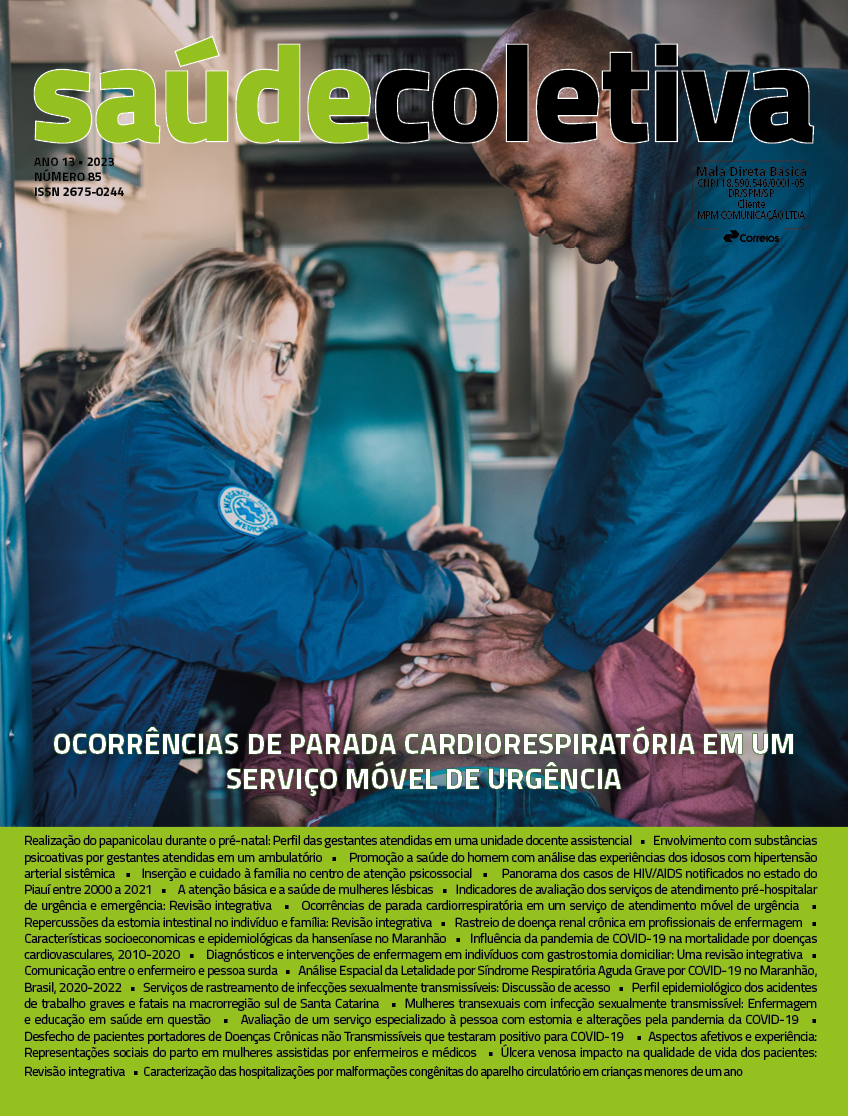Sexually transmitted infection screening services: Access discussion
DOI:
https://doi.org/10.36489/saudecoletiva.2023v13i85p12688-12701Keywords:
Sexually transmitted infections, Diagnostic screening programsAbstract
Objective: To describe and compare the profile of users of two Sexually Transmitted Infections screening services. Methods: Cross-sectional study with primary data collected between 2020 and 2021. Users were seen at a Pre-Exposure Prophylaxis outpatient clinic and at a Testing and Counseling Center. It had ethical approval, CAAE: 07448818.0.1001.5558. Descriptive analysis and logistic regression were performed. Results: 219 patients participated in the study. The services serve different populations in terms of socioeconomic and behavioral profiles. It was evident that the out patient clinic serves patients who live in more central locations, had a 5.3 times the chance of being gay and 3.5 times the chance of practicing group sex and 70% the chance of having completed higher education. Conclusion. Services have different clientele, so they need to be strategically located to be able to give access to vulnerable populations, both economically and behaviorally, to contain the rates of these diseases on the rise in the country.
References
WHO. Global HIV Hepatitis and Sexually Transmitted Infections Programmes. Global progress report on HIV, viral hepatitis and sexually transmitted infections, 2021 [Internet]. Vol. 53, 2021. Disponível em: https://www.who.int/publications/i/item/9789240027077
Zheng, Y. el. al. Global burden and trends of sexually transmitted infections from 1990 to 2019: an observational trend study. The Lancet. Infectious diseases, 22(4), 541–551. https://doi.org/10.1016/S1473-3099(21)00448-5
Tsuboi M, et al. Prevalence of syphilis among men who have sex with men: a global systematic review and meta-analysis from 2000–20. Lancet Glob Heal. 2021;9(8):e1110–8. Disponível em: https://www.thelancet.com/journals/langlo/article/PIIS2214-109X(21)00221-7/fulltext
Malekinejad, M. et. al. Risk of HIV Acquisition Among Men Who Have Sex With Men Infected With Bacterial Sexually Transmitted Infections: A Systematic Review and Meta-Analysis. Sexually transmitted diseases, 48(10), e138–e148. https://doi.org/10.1097/OLQ.0000000000001403
Brasil. Ministério da Saúde. Diretrizes para organização do CTA no âmbito da prevenção combinada e nas Redes de Atenção à Saúde. Brasília. Ministério da Saúde [Internet]. 2017.Disponível em: http://files/1830/2017.
Schaefer R, et al. Adoption of guidelines on and use of oral pre-exposure prophylaxis: a global summary and forecasting study. Lancet HIV. 2021;8(8):e502–10.
Brasil. Ministério da Saúde. Secretaria de Vigilância em Saúde. Departamento de Vigilância, Prevenção e Controle das Infecções Sexualmente Transmissíveis, do HIV/Aids e das Hepatites Virais.Profilaxia pré-exposição (PrEP) de risco à infecção pelo HIV [Internet]. Brasília. Misnistério da Saúde. Disponível em: http://www.aids.gov.br/publicacao/2017/protocolo-clinico-e-diretrizes-terapeuticas-para-profilaxia-pre-exposicao-prep-de-ri
Pereira CCDA, et al. Preferences for pre-exposure prophylaxis (PrEP) among men who have sex with men and transgender women at risk of HIV infection: A multicentre protocol for a discrete choice experiment in Brazil. BMJ Open. 2021;11(9):1–6.
Ministério da Saúde.org [Internet]. Painel PrEP; 2022 [citado em 2012, 08 de setembro]. Disponível em: https://www.gov.br/aids/pt-br/assuntos/prevencao-combinada/prep-profilaxia-pre-exposicao/painel-prep.
Torres TS. et al. Impact of COVID-19 Pandemic on Sexual Minority Populations in Brazil: An Analysis of Social/Racial Disparities in Maintaining Social Distancing and a Description of Sexual Behavior. AIDS Behav. 2021;25(1):73–84.
VILLELA, LM. Percepções sobre o uso da profilaxia pré-exposição ao HIV (PrEP) e possível compensação de risco entre homens que fazem sexo com homens (HSH) e mulheres transexuais (TRANS) potencialmente elegíveis para o uso de PrEP no estudo PrEP Brasil. Rio de Janeiro, 2018. 62 f. Dissertação [Mestrado em Pesquisa Clínica em Doenças Infecciosas] – Instituto Nacional de Infectologia Evandro Chagas, Fundação Oswaldo Cruz.
Traeger MW, et al. Effects of Pre-exposure Prophylaxis for the Prevention of Human Immunodeficiency Virus Infection on Sexual Risk Behavior in Men Who Have Sex with Men: A Systematic Review and Meta-analysis. Clin Infect Dis. 2018;67(5):676–86.
Murchu E, et al. Oral pre-exposure prophylaxis (PrEP) to prevent HIV: a systematic review and meta-analysis of clinical effectiveness, safety, adherence and risk compensation in all populations. BMJ Open. 2022;12(5):e048478.
Oliveira RCP de,et al. Avaliação do estigma relacionado ao uso de prep em homens que fazem sexo com homens (HSH) / Evaluation of the stigma related to the use of prep in men who have sex with men (MSM). Brazilian J Heal Rev. 2020;3(5):12924–34.
Mir, J. F, et. al. Implementation models and access to HIV pre-exposure prophylaxis in Spain. Modelos de implementación y acceso a la profilaxis preexposición para el VIH en España. Enfermedades infecciosas y microbiologia clinica (English ed.), 38(5), 234–237. https://doi.org/10.1016/j.eimc.2019.05.004, 2020.
SSaes M de O, Duro SMS, Gonçalves C de S, Tomasi E, Facchini LA. Assessment of the appropriate management of syphilis patients in primary health care in different regions of Brazil from 2012 to 2018.
Ssekamatte T, et al. Barriers to access and utilisation of HIV/STIs prevention and care services among trans-women sex workers in the greater Kampala metropolitan area, Uganda. BMC Infect Dis. 2020;20(1):1–15.
Ramos Jr. AN. Persistência da sífilis como desafio para a saúde pública no Brasil: o caminho é fortalecer o SUS, em defesa da democracia e da vida. Cad Saude Publica. 2022;38(5):1–6.
Brasil. Ministério da Saúde. Secretaria de Vigilância em Saúde. Departamento de Doenças de Condições Crônicas e Infecções Sexualmente Transmissíveis. Agenda Estratégica para Redução da Sífilis no Brasil 2020-2021 [recurso eletrônico]. Brasília: Ministério da Saúde, 2021.
Marellapudi A, et al. Understanding and addressing privacy and confidentiality concerns associated with the provision of mobile HIV care: a qualitative study. AIDS Care - Psychol Socio-Medical Asp AIDS/HIV. 2022;34(5):575–9.
Ministério da Saúde.org [Internet]. Informação e Gestão da Atenção Básica ; 2022 [citado em 2012, 08 de setembro]. Disponível em: https://egestorab.saude.gov.br/paginas/acessoPublico/relatorios/relCoberturaA%20PSCadastro.xhtml
Ministério da Saúde.org [Internet]. Informação e Gestão da Atenção Básica; 2022 [citado em 2012, 08 de setembro]. Disponível em:https://egestorab.saude.gov.br/paginas/acessoPublico/relatorios/relCoberturaA%20PSCadastro.xhtml
Gras G. Use of telemedicine in the management of infectious diseases. Vol. 48, Medecine et Maladies Infectieuses. 2018. p. 231–7.
Gamoudi D, et al. European guideline on the organization of a consultation for sexually transmitted infections. J Eur Acad Dermatology Venereol. 2019;33(8):1452–8.







